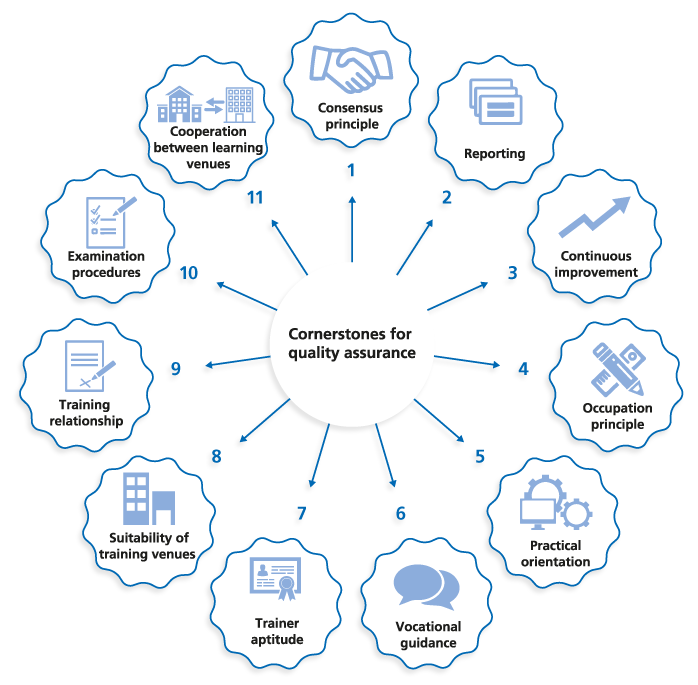Cornerstones for quality assurance
DEQA-VET has identified eleven cornerstones for quality assurance in company-based training. This attempt was undertaken to represent the quality assurance mechanisms in a simplified form.

DEQA-VET has identified eleven cornerstones for quality assurance in company-based training. This attempt was undertaken to represent the quality assurance mechanisms in a simplified form.

Please click on the individual terms of the graphic. Here you can find more delailed information. The information is shown below the graphic.













The state, the employers and employees act together in accordance with the consensus principle to shape the dual system
Description
Within the dual system, the Federal Government is responsible for the company-based element of training whilst the school-based component falls within the remit of the federal states. The employers and employees are equally represented via their respective umbrella organisations in the management committees at regional and national level. They have equal voting rights in the VET committees at the chambers, in the Federal State Committees for Vocational Education and Training and in the Board, and the sub-committees and working groups of the Federal Institute for Vocational Education and Training (BIBB). (…) read more
Vocational education and training planning is based on indicators-aided reporting
Description
The Federal Ministry of Education and Research (BMBF) constantly monitors developments in VET. By 1 April each year, it publishes a “Report on Vocational Education and Training”. This report sets out the current status and probable further development of vocational education and training. It contains information for the previous calendar year on VET contracts that have been concluded and are still in existence, on the number of vacant training places, and on persons registered as training place applicants. Demand for and supply of training places for the respective current calendar year are also forecast. (….) read more
Modernisation mechanisms, research and development projects, pilot projects and projects conducted together with practice achieve a continuous improvement of the system
Description
The constituent elements of the dual system are evaluated on an ongoing basis and modernised with consideration of economic, societal and technical developments.
VET research plays a particular role in the modernisation process. This encompasses the clarification of the basic principles underlying vocational education and training, observation of domestic, European and international developments, identification of requirements regarding the contents and aims of VET, preparation of further developments in vocational education and training in respect of changes to economic, societal and technical needs, the promotion of instruments and procedures for the imparting of VET and knowledge and technology transfer. (...) read more
The structuring of training regulations is based on the occupation principle (Berufsprinzip)
Description
328 recognised training occupations (as of 2016) are regulated in a nationally standardised way by means of their respective training regulations. These stipulate minimum standards. They include information on the title of the recognised training occupation, duration of training, the training profile (professional skills, knowledge and competences), the general training plan (content and time structure of training) and the examination requirements. (…) read more
State-recognised training occupations are designed in a practice-oriented way and are updated
Description
The regulation of state-regulated training occupations is agreed in a standardised manner by the Federal Government, the federal states, the employers and the employees. Training regulations are monitored on a regular basis and, as soon as a specific need arises, adapted to meet developments in society, the economy and technology. These developments may also lead to new training occupations in new fields of employment. (…) read more
When selecting training, young people receive support from vocational guidance institutions and programmes and from databases
Description
Support with vocational orientation begins whilst young people are still at school. Various approaches in this regard are in place in the federal states. Most schools have practical placement weeks which offer pupils an insight into the world of work. In addition, career entry support workers are available to some schools and are able to provide assistance with matters such as searching for a training place. The BMBF’s vocational orientation programme enables pupils to explore their strengths via an analysis of potential and then try out various occupational fields in a workshop. (…) read more
Trainers are personally and professionally suited to impart training contents
Description
Pursuant to the BBiG, trainers must be personally suited. Those deemed not to be suited are persons who are not permitted to employ children or young people or who have breached the BBiG and its relevant provisions. Trainers are in possession of the necessary occupational and vocational teaching skills, knowledge and competences. They have passed a state-recognised examination in a specialism that is relevant to the training occupation. (…) read more
Training venues are suitable for vocational education and training in terms of their nature and equipment
Description
The process of ascertaining the suitability of the training venue is initiated as soon as a company registers a training contract with the chamber. Suitability is identified only for the training occupation in question and is not valid generally. The relevant training regulations are available to the training venue. The general training plan is used to develop a company training plan which contains information on specific workplaces, phases of training, training contents to be imparted and training times allocated. (…) read more
Rights and obligations of the training contract are regulated
Description
The conclusion of a training contract and the registration of such a contract with the competent body are a prerequisite for training. The contractual partners are the party providing training (defined as a party which recruits other persons for vocational education and training) and the trainee. Consent from a legal guardian is required for trainees aged under 18. Trainees are entitled to receive remuneration and paid leave. Training allowances rise annually as the vocational education and training progresses. (…) read more
The occupational proficiency (berufliche Handlungsfähigkeit) gained by trainees is identified by an examination board of the competent body following a valid procedure
Description
Final or journeyman examinations identify the acquisition of occupational proficiency (berufliche Handlungsfähigkeit). Candidates are required to demonstrate mastery of the necessary occupational skills, possession of the required occupational knowledge and competences and familiarity with the teaching material imparted via teaching at the vocational school. In order to determine status of training during the training process, an intermediate examination is conducted in accordance with the training regulations. The training regulations may instead stipulate that the final examination takes place in two different parts conducted at different times (extended final examination). (…) read more
Companies and vocational schools collaborate in the implementation of vocational education and training
Description
Coordination of the training contents resulting from the training regulations and skeleton curricula for the learning venues of the company and the vocational school is best achieved within the scope of close cooperation between these learning venues. The introduction of learning fields by means of the framework curricula means that both learning venues are responsible for the acquisition of practical competencies. The learning field concept helps to concentrate cooperation between the learning venues via the joint development of cross-venue training projects for the better linking of theory and practice. (…) read more